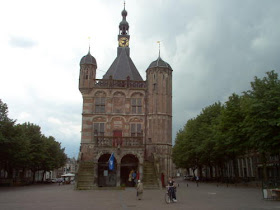Some stuff about hops today. I would write a witty and erudite introduction, but I can't be arsed.
 Hops
HopsDifferent varieties had gradually developed over a period of two or three hundred years as growers selected hops with particular qualities to plant. Sometimes flavour was paramount, but other characteristics such as the yield and disease resistance were also important. "It [selection] has resulted in the cultivation in a large number of districts of hops of homogenous type, particularly suited to the soil and climatic conditions, and also in the elimination of apaprently well-established varieties and replacement by others which met with a greater degree of approval." (Source: "Brewing Science & Practice" H. Lloyd Hind, 1943, pages 387-388.)
During WW I, when the hop industry came under government control, the different types of hops were classified into four groups: Goldings, Golding Varieties, Fuggle's and Tolhursts. Though many of the hops classified as Golding Varieties had little relation to Goldings. The differentiation was based as much on the use of the hops as on genetic relationship. Hops with the most delicate flavour were put into the Golding Varieties group. Such hops were often used for dry-hopping, while stronger flavoured Fuggle's and the lower-quality Tolhursts were used in the copper. (Source: "Brewing Science & Practice" H. Lloyd Hind, 1943, page 388.)
GoldingsThese were named after a Mr. Golding who at the end of the 18th century selected a hop plant from a garden in Canterbury. By the 20th century, the name was being used for several related varieties grown in the best hop-growing regions of East Kent, Worcester and Hereford. They had a delicate flavour and good preservative properties but did not crop as heavily as other varieties. (Source: "Brewing Science & Practice" H. Lloyd Hind, 1943, page 388.)
The Canterbury Whitebine or Canterbury Golding was one of the oldest and best types. Very similar to this, and probably closely related, were the Worcester Mathon and the Farnham Whitebine. In Kent and Worcester the Bramling, an early-ripening hop first cultivated in 1865, was widely grown. It was a development of the Golding and had a similarly good aroma and preservative qualities. Amos' Early Bird was a further development of the Bramling that cropped better and earlier, but was of a slightly lower quality. (Source: "Brewing Science & Practice" H. Lloyd Hind, 1943, pages 388-389.)
For dry hopping, Barclay Perkins used mostly East Kent Goldings. They also used them sometimes as copper hops.
 Golding Varieties
Golding VarietiesThere were two main types of Golding Varieties. The Cobb, selected from a garden of Canterbury Whitebines in 1881, which had a good flavour but poor preservative power. It was very good as a dry hop. The Tutsham cropped well but was of only average quality. (Source: "Brewing Science & Practice" H. Lloyd Hind, 1943, page 389.)
Fuggle'sWidely grown in Kent, Sussex, Hereford and Worcester, Fuggle's was the commonest copper hop. It cropped well, had a high lupulin content, but had a coarser flavour than Goldings. It was particularly suited to the soil in Hereford and Worcester. (Source: "Brewing Science & Practice" H. Lloyd Hind, 1943, page 389.)
Barclay Perkins used Fuggle's as a copper hop for most of their beers.
TolhurstA collection of low-quality, but heavy-cropping, varieties which were widely planted after WW I, when new hop gardens needed to be developed quickly. By 1940 it had gone out of favour on account of its poor flavour and preservative power and was no longer widely grown. (Source: "Brewing Science & Practice" H. Lloyd Hind, 1943, pages 389-390.)
New varietiesSeveral new varieties of hop were developed at the South-Eastern Agricultural College at Wye in Kent. They included Brewer's Favourite, Brewer's Gold, Fillpocket and Quality Hop. All had excellent preservative qualities but not such a great aroma. They were used in the copper in conjunction with other, better-flavoured hops. None of these new varieties was widely grown before WW II. (Source: "Brewing Science & Practice" H. Lloyd Hind, 1943, page 390.)

















































